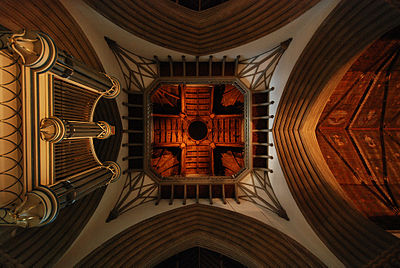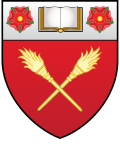| Main page | Indices | Projects |
The University of Oxford portal
The University of Oxford is a collegiate research university in Oxford, England. There is evidence of teaching as early as 1096, making it the oldest university in the English-speaking world and the world's second-oldest university in continuous operation. It grew rapidly from 1167, when Henry II banned English students from attending the University of Paris. After disputes between students and Oxford townsfolk in 1209, some academics fled north-east to Cambridge where they established what became the University of Cambridge. The two English ancient universities share many common features and are jointly referred to as Oxbridge.
The University of Oxford is made up of 43 colleges, consisting of 36 semi-autonomous constituent colleges, four permanent private halls and three societies (colleges that are departments of the university, without their own royal charter), and a range of academic departments which are organised into four divisions. Each college is a self-governing institution within the university, controlling its own membership and having its own internal structure and activities. All students are members of a college. The university does not have a main campus, but its buildings and facilities are scattered throughout the city centre. Undergraduate teaching at Oxford consists of lectures, small-group tutorials at the colleges and halls, seminars, laboratory work and occasionally further tutorials provided by the central university faculties and departments. Postgraduate teaching is provided in a predominantly centralised fashion.
Oxford operates the Ashmolean Museum, the world's oldest university museum; Oxford University Press, the largest university press in the world; and the largest academic library system nationwide. In the fiscal year ending 31 July 2023, the university had a total consolidated income of £2.92 billion, of which £789 million was from research grants and contracts.
Oxford has educated a wide range of notable alumni, including 30 prime ministers of the United Kingdom and many heads of state and government around the world. 73 Nobel Prize laureates, 4 Fields Medalists, and 6 Turing Award winners have matriculated, worked, or held visiting fellowships at the University of Oxford, while its alumni have won 160 Olympic medals. Oxford is the home of numerous scholarships, including the Rhodes Scholarship, one of the oldest international graduate scholarship programmes. (Full article...)
Selected article
The buildings of Nuffield College are to the west of Oxford's city centre, on the former site of the largely disused basin of the Oxford Canal. Nuffield College was founded in 1937 after a donation to the University of Oxford by the car manufacturer Lord Nuffield. The initial designs of the architect Austen Harrison, which were heavily influenced by Mediterranean architecture, were rejected by Nuffield, who described them as "un-English". Harrison then aimed for "something on the lines of Cotswold domestic architecture", as Nuffield wanted. The college was built to the revised plans between 1949 and 1960. During construction, the tower, about 150 feet (46 m) tall, was redesigned to hold the college's library. Reaction to the architecture has been largely unfavourable. It has been described as "Oxford's biggest monument to barren reaction" and "a hodge-podge from the start". However, the architectural historian Sir Nikolaus Pevsner thought that the tower helped the Oxford skyline and predicted that it would "one day be loved". The writer Simon Jenkins doubted Pevsner's prediction, though, saying that "vegetation" was the "best hope" for the tower, and for the rest of the college too. (Full article...)
Selected biography
Selected college or hall
Harris Manchester College, on Mansfield Road just to the east of the city centre, was established in 1786 in Manchester, and was initially called the Manchester Academy. It provided education to religious non-conformists who at that time were not allowed to study at the universities of Oxford or Cambridge. Between 1803 and 1840, the academy was based in York to accommodate its principal, Charles Wellbeloved, who would not move to Manchester. After a period in London (1853 to 1889), it moved to Oxford, with buildings designed by the architect Thomas Worthington opening in 1893. The chapel has ornate wood carvings and notable stained-glass windows by Sir Edward Burne-Jones and William Morris. It became a Permanent Private Hall of the university in 1990, and gained full college status in 1996. The college's name reflects its history in Manchester and a donation from Lord Harris of Peckham. It has about 110 undergraduate students and 40 postgraduates, all of whom are mature students (over 21), and is one of the smallest colleges at Oxford; the Principal is the theologian Ralph Waller, who is also Director of the Farmington Institute for Christian Studies which is based at the college. (Full article...)
Selected image

Did you know
Articles from Wikipedia's "Did You Know" archives about the university and people associated with it:
- ... that Seymour King, Member of Parliament for Kingston upon Hull Central for 25 years, was the first climber to reach the summits of Mont Maudit and Aiguille Blanche de Peuterey (pictured)?
- ... that Andrew N. Meltzoff's research revealed that infants of only a few weeks of age can imitate facial expressions and hand gestures?
- ... that civil engineer Robert Wynne-Edwards was the first President of the Institution of Civil Engineers to be elected while still working as a contractor?
- ... that Irish cricketer and artist Robert Gregory was the subject of four poems by W. B. Yeats?
- ... that when a rival took over an estate belonging to Sir Walter Clarges, Clarges used his position as a Member of Parliament to send the interloper to jail?
Selected quotation
Selected panorama
On this day
Events for 20 June relating to the university, its colleges, academics and alumni. College affiliations are marked in brackets. Other events
- 2012 – Aung San Suu Kyi (St Hugh's) is awarded an honorary doctorate at the Encaenia ceremony.
Wikimedia
The following Wikimedia Foundation sister projects provide more on this subject:
-
Commons
Free media repository -
Wikibooks
Free textbooks and manuals -
Wikidata
Free knowledge base -
Wikinews
Free-content news -
Wikiquote
Collection of quotations -
Wikisource
Free-content library -
Wikiversity
Free learning tools -
Wikivoyage
Free travel guide -
Wiktionary
Dictionary and thesaurus
© MMXXIII Rich X Search. We shall prevail. All rights reserved. Rich X Search














